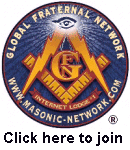
The GFN Treasure Chest Archives
www.masonic-network.com
"Where Master Masons Communicate"

 |
The GFN Treasure Chest Archiveswww.masonic-network.com |
 |
The skirret, or some implement like it, must have been in use for thousands of years. Paintings at Thebes, Egypt, dating back to, say, 3000 B.c., show masons holding a stretched cord by means of which a line is being drawn. A limestone 'stela' ('slab' or 'tablet') set up in the capital Ur of the Chaldees more than two thousand years before. A simple Form of the Skirret. The Everyday Skirret
A line-holder, rotating on a centre-pin. The gardener's line-reel and stake. Christ shows a measuring rod and line in use by a deity acting as architect. But, while this is so, we have no evidence of the actual existence of the implement itself earlier than a painting, The Backgammon Players, by the Flemish painter David Teniers the younger, who may be assumed to have produced his picture in the middle of the seventeenth century. We find no reference in print to the word 'skirret' until after the United Grand Lodge, 1813, and then as a masonic word only, and not as a word in general literature.
The skirret familiar to every freemason is a spool, or cord-holder rotating freely on a centre-pin. The loose end of the cord is attached to a second pin-a short stake-which, in use, is driven into the ground at one end of the intended line. Next, the workman walks towards the other end of the proposed line, the rotating holder giving off the cord as he moves, and he then drives the centre-pin into the ground where required, taking care to stretch the cord tightly. In this way he produces a straight line for his guidance " in marking out the ground for the foundation of an intended structure."
Some rituals speak of the skirret as being an implement from which the line "is drawn, chalked and struck"-that is, the stretched and chalked cord is 'plucked,' so as to print a white line on the surface below it. We may well believe that the use of the chalk-line has been known for thousands of years. The ancient Greeks said that the chalk-line produced a line "more exact than rectitude itself" - symbolically it was the boundary line of human life.. But for use on an earth surface, the only purpose of the skirret, the chalked line would not often be suitable.
We know the implement well enough, but we know nothing of its name. General dictionaries appear to have drawn their information on the subject from masonic sources, and therefore do not help us. (It is fairly certain, by the way, that freemasonry gave this word 'skirret' to the technical vocabulary or, at any rate, rescued it from oblivion.) Some erudite and elaborate interpretations giving the word a symbolic meaning have been attempted, but can be ignored. One writer has said that the word is "genuine English although almost obsolete." Yes, genuine English for certain things botanical, but not for a rotating line holder! Dictionaries of the present century give the word 'skirreh' as meaning a cord, but it is doubtful whether this has genuine antiquity. A few years ago an author occupied much space to explain that the word .skirret' meant 'pure,' but this looks very much like a case of taking the masonic meaning of a word, and seeking to derive it accordingly. 'Purity' is an extremely unlikely association with the name for an operative's linespool.
The word 'skirret' was not known, it is believed, until about 1825, and appears to have no literary history; we must conclude that if the word itself was not an invention, then it must have been derived from some fact or circumstance relating to the implement itself.
There is a bare possibility that the familiar word 'skewer'-the butcher's skewer-is allied with the word 'skirret.' One old-fashioned meaning of 'skewer' is that of a spindle fixed to a cloth-spinner's creel, and carrying a rotating bobbin from which the yarn was unwound; here we get both the sound' of the word and the meaning closely allied to those of 'skirret.'
The Scots word 'skirr, meaning 'scurry or rush,' conveys the exact mental impression caused by the sudden rotation of the cordholder when the pull comes upon it. Then, in eighteenth century slang, to 'skirry' was to 'run quickly' or to 'scurry.' We may suspect that 'skirret' was originally a colloquial word which owed its origin either to the 'scurry' of the line-holder or to the 'skirl,' or shrill sound, which it makes when in action.